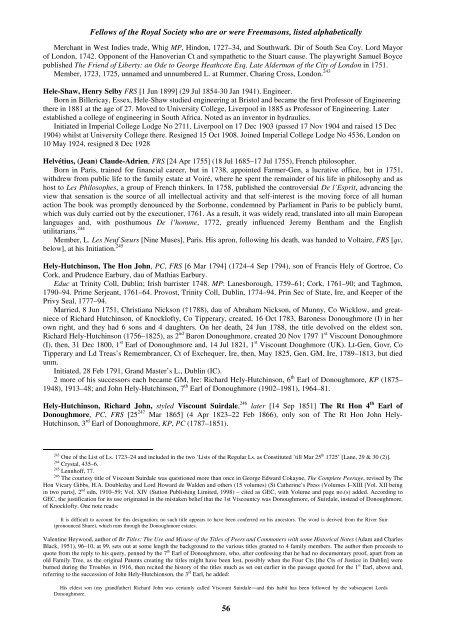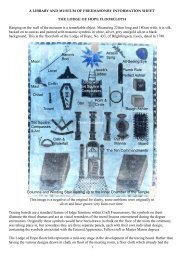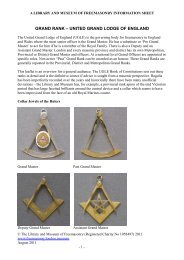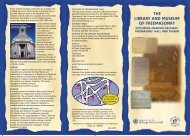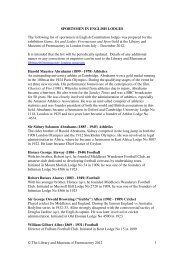FREEMASONS AND THE ROYAL SOCIETY Alphabetical List of ...
FREEMASONS AND THE ROYAL SOCIETY Alphabetical List of ...
FREEMASONS AND THE ROYAL SOCIETY Alphabetical List of ...
You also want an ePaper? Increase the reach of your titles
YUMPU automatically turns print PDFs into web optimized ePapers that Google loves.
Fellows <strong>of</strong> the Royal Society who are or were Freemasons, listed alphabetically<br />
Merchant in West Indies trade, Whig MP, Hindon, 1727–34, and Southwark. Dir <strong>of</strong> South Sea Coy. Lord Mayor<br />
<strong>of</strong> London, 1742. Opponent <strong>of</strong> the Hanoverian Ct and sympathetic to the Stuart cause. The playwright Samuel Boyce<br />
published The Friend <strong>of</strong> Liberty: an Ode to George Heathcote Esq, Late Alderman <strong>of</strong> the City <strong>of</strong> London in 1751.<br />
Member, 1723, 1725, unnamed and unnumbered L. at Rummer, Charing Cross, London. 243<br />
Hele-Shaw, Henry Selby FRS [1 Jun 1899] (29 Jul 1854-30 Jan 1941). Engineer.<br />
Born in Billericay, Essex, Hele-Shaw studied engineering at Bristol and became the first Pr<strong>of</strong>essor <strong>of</strong> Engineering<br />
there in 1881 at the age <strong>of</strong> 27. Moved to University College, Liverpool in 1885 as Pr<strong>of</strong>essor <strong>of</strong> Engineering. Later<br />
established a college <strong>of</strong> engineering in South Africa. Noted as an inventor in hydraulics.<br />
Initiated in Imperial College Lodge No 2711, Liverpool on 17 Dec 1903 (passed 17 Nov 1904 and raised 15 Dec<br />
1904) whilst at University College there. Resigned 15 Oct 1908. Joined Imperial College Lodge No 4536, London on<br />
10 May 1924, resigned 8 Dec 1928<br />
Helvétius, (Jean) Claude-Adrien, FRS [24 Apr 1755] (18 Jul 1685–17 Jul 1755), French philosopher.<br />
Born in Paris, trained for financial career, but in 1738, appointed Farmer-Gen, a lucrative <strong>of</strong>fice, but in 1751,<br />
withdrew from public life to the family estate at Voiré, where he spent the remainder <strong>of</strong> his life in philosophy and as<br />
host to Les Philosophes, a group <strong>of</strong> French thinkers. In 1758, published the controversial De l’Esprit, advancing the<br />
view that sensation is the source <strong>of</strong> all intellectual activity and that self-interest is the moving force <strong>of</strong> all human<br />
action The book was promptly denounced by the Sorbonne, condemned by Parliament in Paris to be publicly burnt,<br />
which was duly carried out by the executioner, 1761. As a result, it was widely read, translated into all main European<br />
languages and, with posthumous De l’homme, 1772, greatly influenced Jeremy Bentham and the English<br />
utilitarians. 244<br />
Member, L. Les Neuf Sœurs [Nine Muses], Paris. His apron, following his death, was handed to Voltaire, FRS [qv,<br />
below], at his Initiation. 245<br />
Hely-Hutchinson, The Hon John, PC, FRS [6 Mar 1794] (1724–4 Sep 1794), son <strong>of</strong> Francis Hely <strong>of</strong> Gortroe, Co<br />
Cork, and Prudence Earbury, dau <strong>of</strong> Mathias Earbury.<br />
Educ at Trinity Coll, Dublin; Irish barrister 1748. MP: Lanesborough, 1759–61; Cork, 1761–90; and Taghmon,<br />
1790–94. Prime Serjeant, 1761–64. Provost, Trinity Coll, Dublin, 1774–94. Prin Sec <strong>of</strong> State, Ire, and Keeper <strong>of</strong> the<br />
Privy Seal, 1777–94.<br />
Married, 8 Jun 1751, Christiana Nickson (†1788), dau <strong>of</strong> Abraham Nickson, <strong>of</strong> Munny, Co Wicklow, and greatniece<br />
<strong>of</strong> Richard Hutchinson, <strong>of</strong> Knockl<strong>of</strong>ty, Co Tipperary, created, 16 Oct 1783, Baroness Donoughmore (I) in her<br />
own right, and they had 6 sons and 4 daughters. On her death, 24 Jun 1788, the title devolved on the eldest son,<br />
Richard Hely-Hutchinson (1756–1825), as 2 nd Baron Donoughmore, created 20 Nov 1797 1 st Viscount Donoughmore<br />
(I), then, 31 Dec 1800, 1 st Earl <strong>of</strong> Donoughmore and, 14 Jul 1821, 1 st Viscount Doughmore (UK). Lt-Gen, Govr, Co<br />
Tipperary and Ld Treas’s Remembrancer, Ct <strong>of</strong> Exchequer, Ire, then, May 1825, Gen. GM, Ire, 1789–1813, but died<br />
unm.<br />
Initiated, 28 Feb 1791, Grand Master’s L., Dublin (IC).<br />
2 more <strong>of</strong> his successors each became GM, Ire: Richard Hely-Hutchinson, 6 th Earl <strong>of</strong> Donoughmore, KP (1875–<br />
1948), 1913–48; and John Hely-Hutchinson, 7 th Earl <strong>of</strong> Donoughmore (1902–1981), 1964–81.<br />
Hely-Hutchinson, Richard John, styled Viscount Suirdale, 246 later [14 Sep 1851] The Rt Hon 4 th Earl <strong>of</strong><br />
Donoughmore, PC, FRS [25 247 Mar 1865] (4 Apr 1823–22 Feb 1866), only son <strong>of</strong> The Rt Hon John Hely-<br />
Hutchinson, 3 rd Earl <strong>of</strong> Donoughmore, KP, PC (1787–1851).<br />
243 th<br />
One <strong>of</strong> the <strong>List</strong> <strong>of</strong> Ls. 1723–24 and included in the two ‘<strong>List</strong>s <strong>of</strong> the Regular Ls. as Constituted ’till Mar 25 1725’ [Lane, 29 & 30 (2)].<br />
244<br />
Crystal, 435–6.<br />
245<br />
Lennh<strong>of</strong>f, 77.<br />
246<br />
The courtesy title <strong>of</strong> Viscount Suirdale was questioned more than once in George Edward Cokayne, The Complete Peerage, revised by The<br />
Hon Vicary Gibbs, H.A. Doubleday and Lord Howard de Walden and others (15 volumes) (St Catherine’s Press (Volumes I–XIII [Vol. XII being<br />
in two parts], 2 nd edn, 1910–59; Vol. XIV (Sutton Publishing Limited, 1998) – cited as GEC, with Volume and page no.(s) added. According to<br />
GEC, the justification for its use originated in the mistaken belief that the 1st Viscountcy was Donoughmore, <strong>of</strong> Suirdale, instead <strong>of</strong> Donoughmore,<br />
<strong>of</strong> Knockl<strong>of</strong>ty. One note reads:<br />
It is difficult to account for this designation; no such title appears to have been conferred on his ancestors. The word is derived from the River Suir<br />
(pronounced Shure), which runs through the Donoughmore estates.<br />
Valentine Heywood, author <strong>of</strong> Br Titles: The Use and Misuse <strong>of</strong> the Titles <strong>of</strong> Peers and Commoners with some Historical Notes (Adam and Charles<br />
Black, 1951), 96–10, at 99, sets out at some length the background to the various titles granted to 4 family members. The author then proceeds to<br />
quote from the reply to his query, penned by the 7 th Earl <strong>of</strong> Donoughmore, who, after confessing that he had no documentary pro<strong>of</strong>, apart from an<br />
old Family Tree, as the original Patents creating the titles might have been lost, possibly when the Four Cts [the Cts <strong>of</strong> Justice in Dublin] were<br />
burned during the Troubles in 1916, then recited the history <strong>of</strong> the titles much as set out earlier in the passage quoted for the 1 st Earl, above and,<br />
referring to the succession <strong>of</strong> John Hely-Hutchionson, the 3 rd Earl, he added:<br />
His eldest son (my grandfather) Richard John was certainly called Viscount Suirdale―and this habit has been followed by the subsequent Lords<br />
Donoughmore.<br />
56


